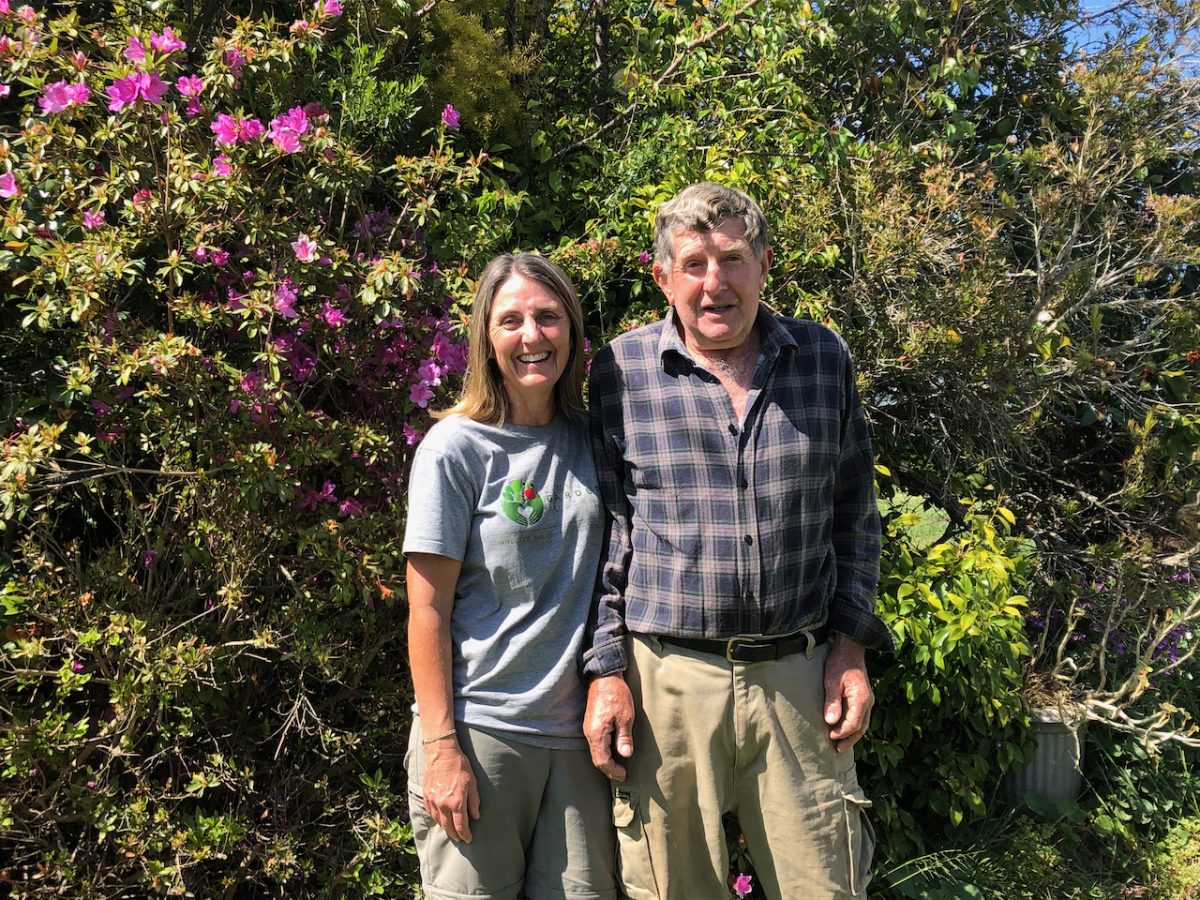
Louise Marcinkowski, one of the participating farmers in the Bodalla area, and Sharlene Cohen, a volunteer with Eurobodalla Koala Project. Photo: Marion Williams.
Eurobodalla isn’t known for its koalas but volunteer group Eurobodalla Koala Project (EKP) is changing that by helping the small local koala population to recover.
It is working with three neighbouring farmers to create a corridor between the Bodalla and Dampier state forests, west of Bodalla. They are encouraged by sightings of koalas.
EKP has been running for 12 years. Until recently, it was led by Dr Keith Joliffe who researched koala habitat on private land. Given Eurobodalla isn’t a priority area, EKP credits his work for EKP receiving a $200,000 grant from the Commonwealth’s Saving the Koalas Round 2 funding in October 2023.
EKP project administrator Sharlene Cohen said there were known koala populations in Bermagui and Numeralla, but little was known about Eurobodalla’s koalas. “We felt the Commonwealth saw an opportunity to get more information on an area that hasn’t received much attention,” she said.

Eurobodalla Koala Project project administrator Sharlene Cohen with some of the 12 species of koala trees they are planting to create koala corridors. Photo: Marion Williams.
In April EKP did an 1800-hectare thermal drone night survey across private land, state forest and national parks. They found one koala in Bodalla State Forest and two around Dignams Creek. “It was very exciting to see those three and we feel very confident of finding more,” Ms Cohen said.
The survey also picked up greater gliders in Mogo State Forest and yellow-bellied gliders in Dampier State Forest.
EKP’s second milestone, is Josh Gowers completing its story map a few months ago. It records all historic and current koala sightings, maps their high priority food trees, and shows how fragmentation, mainly agricultural land, is disrupting koala corridors. Ms Cohen said it was an easy-to-use reference tool.
The third milestone, planting 6000 trees on private land with the help of contractor Bowantz Bushfire and Environmental, is underway. The planting is based on the story map, as well as examining the existing plant communities. Of NSW’s 24 species of koala trees, EKP is planting 12 specific to the area.

Eurobodalla Koala Project project administrator Sharlene Cohen and cattle farmer David Murfin. Photo: Marion Williams.
After letter box drops, putting up posters and door knocking, EKP is working on nine sites with six farmers. All properties have significant corridor or shelter belt connections from one forest to another.
Ms Cohen said the impact could be felt in three to five years. At that age, good koala trees will be two to four metres high and are good for forage although not habitat.
That said, an 1800-hectare survey and 6000 trees aren’t a lot in the scheme of things, the corridors are just stepping-stones, and there is no guarantee of success.
The stakes are high. “If we don’t get this situation under control, koalas will be extinct in NSW by 2050,” Ms Cohen said.

The koala in Bodalla that was identified by the drone survey. Photo: Eurobodalla Koala Project.
Over time the trees will also benefit gliders, gang gangs and glossy black cockatoos.
EKP received an unexpected boost with involvement from the NSW Department of Climate Change, Energy, the Environment and Water.
It suggested EKP put out audio recorders called song meters to pick up the mating calls of male koalas during October. Working with NSW Koala Science Team and Forestry, EKP is placing 60 song meters in strategic locations across the shire.
After 14 days, they will be taken to a lab and examined, with the results due early next year. It is GPS-located and recorded.
After EKP discovered the koalas and gliders, Forestry announced it was doing a song meter blitz in Bodalla. “That is a virtuous spin-off from our work,” Ms Cohen said.

Eurobodalla Koala Project project administrator Sharlene Cohen with Ken Collett, one of the Bodalla farmers participating in the project. Photo: Marion Williams.
The three participating farmers west of Bodalla were surprised to hear that a koala had been sighted in the area.
Annette Collett said planting trees for koalas had not occurred to her, particularly after all the fires came through. “I think they need a helping hand with everything that is going on, and the bush being developed,” Mrs Collett said.
Louise Marcinkowski got involved so that the lone koala can get across the river. “We have to get a healthy group of them going.”
For David Murfin of Riversand Farm it is an opportunity to replenish his property’s stock of trees after he removed many dead ones. Given his plans to open a farm stay, trees make the property more appealing, particularly for ecotourism, as does being involved in a rewilding project.
The planting is on parts of his cattle farm that aren’t particularly productive. “To plant trees that may benefit wildlife is a better use of that land than grass,” Mr Murfin said.
Mrs Collett just hopes the tree plantings work. “We probably won’t see it, but our grandkids might.”
Find out more about EKP on its website or Facebook page.
Original Article published by Marion Williams on About Regional.
















